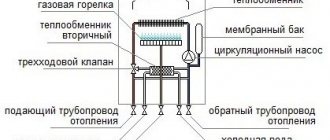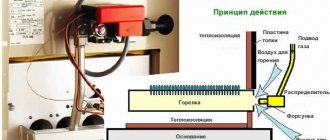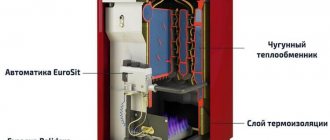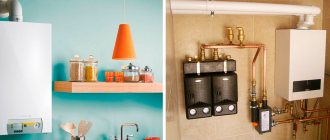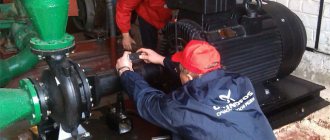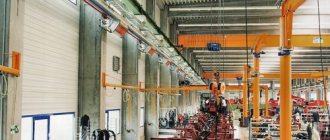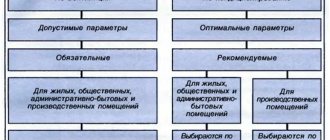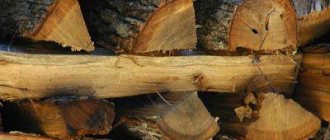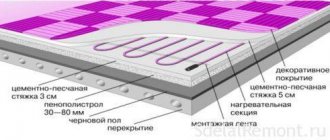Gas burners (burners) are designed to supply a prepared gas-air mixture or separately gas and air to the combustion site, depending on the technological requirements, as well as to ensure stable combustion of gas fuel and regulate the combustion process.
Gas burners (burners) are designed to supply a prepared gas-air mixture or separately gas and air to the combustion site, depending on the technological requirements, as well as to ensure stable combustion of gas fuel and regulate the combustion process.
Combined gas-oil and dust-gas burners allow you to burn gas and fuel oil or gas and coal dust simultaneously or separately. Gas burner GBL-0.45
The following requirements apply to burners:
- the main types of burners must be mass-produced in factories according to technical specifications. If burners are manufactured according to an individual project, then upon commissioning they must undergo tests to determine the main characteristics;
- burners must ensure the passage of a given amount of gas and the completeness of its combustion with a minimum air consumption coefficient α, with the exception of burners for special purposes (for example, for furnaces in which a reducing environment is maintained);
- when ensuring a given technological regime, the burners must ensure a minimum amount of harmful emissions into the atmosphere;
- the noise level generated by the burner should not exceed 85 dB when measured with a sound level meter at a distance of 1 m from the burner and at a height of 1.5 m from the floor;
- burners must operate stably without flame separation or flashover within the design range of thermal power control;
- for burners with preliminary complete mixing of gas and air, the flow rate of the gas-air mixture must exceed the speed of flame propagation;
- to reduce energy consumption for own needs when using burners with forced air supply, the resistance of the air path should be minimal;
- to reduce operating costs, the burner design and stabilizing devices must be fairly easy to maintain and convenient for inspection and repair;
- if it is necessary to preserve reserve fuel, the burners must ensure rapid transfer of the unit from one fuel to another without disturbing the technological regime;
- combined gas-oil burners should provide approximately the same quality of combustion of both types of fuel - gas and liquid (fuel oil).
Burner GBL-2.2
Samples of newly created and operating gas burner devices are subject to state testing.
The main characteristic of a burner is its thermal power, which is understood as the amount of heat (kcal/h) that can be released during complete combustion of the gas supplied through the burner. Thermal power can be calculated by multiplying the gas flow rate (m3/h) by its lower calorific value (kcal/m3).
The main parameters of the burners are determined by GOST 17356-71:
- rated thermal power - the maximum achieved power during long-term operation of the burner, chemical incompleteness of combustion not exceeding the established norm, and at the accepted minimum α;
- nominal gas (air) pressure in front of the burner - gas (air) pressure corresponding to the rated thermal power at atmospheric pressure in the combustion chamber;
- nominal relative length of the torch - the distance along the axis of the torch from the outlet section of the burner, measured at the rated thermal power in the calibers of the outlet, to the point where the CO2 concentration at αg = 1 is 95% of the maximum value;
- coefficient of maximum control of the burner for thermal power - the ratio of the maximum thermal power and the minimum. The maximum power is 0.9 of the power corresponding to the upper limit of stable operation of the burner, and the minimum is 1.1 of the power corresponding to the lower limit of stable operation of the burner;
- burner operating regulation coefficient for thermal power - the ratio of the rated thermal power to the minimum;
- specific heat capacity - the ratio of the burner mass to the rated thermal power;
- noise characteristic of a burner - the level of sound pressure created by a working burner depending on the frequency spectrum.
Basic classification
Categories are generally accepted for the purpose of interpreting differences. They differ in:
- Scope of application – special or universal;
- Pressure level - high pressure (more than 30 kPa), medium (in the range of 5-30 kPa), low pressure (up to 5 kPa).
- The calorific values of the used media are high-calorie, medium-calorie and low-calorie;
- Flame location.
The main difference between special devices and universal ones is the type of firebox where it can be installed. Due to technical parameters, medium or low pressure devices are more widely used. High-calorie units are suitable for use with gases of natural and petroleum origin. The minimum heat index is 20 MJ/m3. The level of fuel for medium-calorie variations is 8-20 MJ/m3.
They are compatible with coke oven gas. For generator or blast furnace gas, use low-calorie analogues with a calorific value of less than 8 MJ/m3. Based on the location of the flame, options can be distinguished on a surface made of refractory material, in a torch, in a chamber or tunnel, on a plane with a porous base, with perforation, or a granular texture with refractory properties.
GOST 17357-71 classifies gas burners according to the following 6 main characteristics:
- combustion air supply method:
- due to vacuum in the furnace or convection;
- air gas injection;
- gas injection with air;
- forced without mixing with gas in the burner;
- forced with the formation of a gas-air mixture in the burner;
- forced from a fan, the rotor of which rotates due to gas energy;
- nominal gas and air pressure;
- heat of combustion of gas;
- rated thermal power;
- nominal relative flame length;
- flame localization, which refers to the method of gas combustion:
- in a free torch;
- in a fireproof tunnel and chamber;
- on a fireproof surface;
- in a porous, perforated or granular refractory mass.
Flame localization
Considering the classifications and designs of gas burners, one more principle of difference between equipment should be noted. Such devices may have different flame localizations. Fire can form in a free torch. In some designs, the flame is contained within a granular, porous or perforated mass. This material is not subject to combustion.
Flame localization can also be observed in a special tunnel or combustion chamber made of refractory material. There are burner designs in which the fire appears directly on the refractory surface.
Depending on the type of such device, the scope of application of the equipment is determined. Thus, burners in which the flame is formed in a fire-resistant tunnel and a free torch are installed in boilers for coolants (water, special antifreeze-based liquids, air, etc.).
If the device burns gas in a porous mass or on a surface made of refractory material, they are installed in other types of heaters. The principle of their operation is based on infrared radiation for heating.
Knowing the existing classifications, you can choose the right type of equipment for a particular boiler. In this case, the operating conditions of the heater are taken into account. A correctly selected burner will operate for many years without requiring repair or replacement.
Burners with air supply to the combustion site due to rarefaction or convection
Gas burner GBL-5.0
When the burner operates in an open space, air flows to the combustion site mainly due to convection and partly due to the injection ability of the burning torch.
When installing a burner in the furnace of the unit, air flows to the combustion site mainly due to vacuum in the furnace and partly due to convection. The mixing of gas with air is carried out not in the burner itself, but behind it - in the embrasure or firebox simultaneously with the combustion process. Such burners are called external mixing or diffusion burners; they are simple in design and practically silent. The diffusion torch is the most resistant to separation; flame penetration is impossible. However, compared to burners with preliminary preparation of the gas-air mixture, their torch length is longer, which accordingly requires large firebox volumes. Complete gas combustion is achieved at lower thermal stresses of the combustion volume and at higher α, the value of which depends on the vacuum in the furnace.
The diameter of the gas holes in such burners is 0.5-3.0 mm, and the distance between them, depending on their diameter and the characteristics of the burned gas, is from 4 to 16 hole diameters. If the distance is greater, the flame will not be able to move from one hole to another. On the contrary, with a small distance between the holes, the flames will merge into one, making it difficult for air to approach each torch individually, which impairs the mixing of gas with air and leads to incomplete combustion.
To increase operating efficiency, these burners are usually manufactured with 2 rows of holes at an angle of 60-90° to each other. In addition, they are installed above grates or perforated metal sheets, through the openings of which air flows to the gas holes in a more or less organized manner. The driving force for air movement is the vacuum in the firebox created by the chimney or exhaust fan.
Main types and classification of gas burners
For a long period there was no particular abundance of this type of product on sale. The simplest boilers, titaniums and geysers were in short supply. The appearance of a gas burner for a boiler with automation was regarded as something fantastic. But these devices also required ventilation with a full chimney. There are even mobile gas-powered infrared picnic burners available these days.
According to modern requirements, gas burners for heating boilers must have low toxicity
Modern fuel units are very diverse. Their advantage is the almost complete combustion of fuel and the absence of the release of toxic impurities when used in closed conditions.
Traditional heating equipment is characterized by design variability:
- atmospheric boilers;
- universal;
- low temperature;
- turbocharged;
- ventilators;
- injection;
- gas burners with piezo ignition.
Do-it-yourself devices are also far from uncommon. Homemade gas burners can be assembled using drawings, diagrams and sketches of craftsmen containing detailed descriptions, as well as watching videos.
Boilers have different types of flame ignition - using a piezo lighter and using a spark when the electronics are triggered.
The advantage of modern gas burners is the almost complete combustion of fuel
It is important! Piezo ignition is a one-time ignition, after which the flame is maintained in operating mode as long as there is a gas supply. This device should not be confused with gas stove burners (nozzle with divider) and grill.
The electronic ignition must be activated when the supply valve is started: the gas is ignited by an electrostatic spark. This option is considered the most economical and reliable, but during power outages the boiler often remains idle (if there is no alternative way to ensure it turns on).
Gas burner with piezo ignition and other methods of maintaining a flame
The variety of burners is determined by a number of characteristics, including the method of air injection and the design features of the firebox itself, which can be:
- open (air comes from the heated room, supply ventilation is needed, combustion products are discharged into the chimney);
- closed type.
Having discovered that the ignition does not work, first of all you need to check its connection to the electrical network
Low-temperature gas burners (atmospheric) are mainly used in open fireboxes. They are distinguished by a simple device and a well-functioning operating principle. Gas is supplied to the wick via an ejector. In this case, the air comes directly from the boiler room where the heating equipment is installed. When ignited, small, low-temperature flames are visible.
This type of gas burners for furnaces and boilers is characterized by low noise levels, accessibility and versatility. Such a device can be adapted for combined fuel stoves, modern specialized equipment and primitive old-style boilers.
The operating principle of a gas burner with piezo ignition is quite simple, especially if the operating parameters of the heating circuit are set. The sensor detects a decrease in temperature, the stop valve and ignition are activated. The blue fuel entering the burner ignites, releasing heat.
Flame control in gas equipment occurs in different ways. In some units everything looks very primitive, others are equipped with electronics. Sometimes complex schemes are used even when upgrading old equipment using a gas burner for a boiler with your own hands.
Gas burners for heating boilers can be of different power and sizes
Attention! If this is an inexpensive burner, then, in all likelihood, it contains a simple thermocouple that will require immediate replacement.
Improved boilers with “smart” options are equipped with an ionization controller that is sensitive to changes. This ensures that the gas is shut off in the event that the flame goes out and there is not enough oxygen for the combustion process (the fuel runs out).
Electronics also respond to increased concentrations of foreign impurities in the blue fuel itself and the combustion byproduct. The gas will be shut off (this is thought out in the SABC gas burner), and the ventilation will begin to operate at full capacity.
Helpful advice! Before cleaning the burner of a gas boiler, it is important to understand its structure by studying the technical documentation containing a description of its operation. Each type of product has its own design differences.
An unstable flame in a gas burner is a sign that you need to call a specialist.
Burners for atmospheric boilers and manual gas burners
Operation due to the natural flow of oxygen ensures complete combustion of fuel; combustion products are removed through a conventional chimney. The operation of the equipment has been simplified with the use of atmospheric type devices and special gas burner nozzles.
Attention! The only condition for the device to operate on oxygen taken from a heated room is excellent supply ventilation.
Important advantages of boilers with atmospheric gas burners:
- independence from power sources, which is important when working in rooms without electricity;
- high reliability (no complex components requiring frequent repairs);
- low noise threshold;
- structural simplicity;
- affordable price.
Important! Information for those who are interested in how much a simple gas burner costs - its price starts from 250 rubles. And the cost of the Ugop-P-16 “Ugolyok” gas burner, for example, is approximately 1000 rubles.
A hand-held gas torch with a cylinder is popular among people performing repairs.
The disadvantages of atmospheric units include:
- the need for a full-fledged chimney that removes smoke and fuel suspension to the outside;
- relatively low efficiency (compared to modernized samples);
- the likelihood of incomplete combustion of fuel due to lack of oxygen;
- difficulty adapting to other heat sources;
- the need to install fresh ventilation or a small window.
Helpful information! Burners with electronic ignition require a high-voltage converter operating from the mains. This distinguishes them from such simple devices as manual gas burners.
Use of ejector burners in finished and converted boilers
A combi boiler with a ceramic gas burner justifies the cost with its versatility, although it is considered an expensive option. Far from budget equipment has a lot of advantages, including autonomous fireboxes:
- for solid fuel;
- with a gas burner.
A ceramic gas burner has a number of advantages over an ejector burner
With this equipment, you can easily switch to coal and firewood, and profitably utilize any organic matter. This is a good opportunity to save on gas, especially in a private home, where there is always the opportunity to find something for recycling.
To supply gas to the burners, additionally equipping them with automation, wood-burning boilers are often equipped with special nozzles or wicks. For these purposes, a simple atmospheric or ejector burner (with air suction) is suitable. In this case, there is no need to redo the entire boiler, since the rest of the boiler operates on the same principle: fuel is burned to obtain thermal energy to warm up the coolant.
Helpful advice! For old domestic equipment, atmospheric gas burners are more suitable, since complete tightness cannot be achieved in them due to the design specifics.
Equipment for automatically ensuring the combustion process in combined boilers can be purchased additionally if you need to convert a wood-burning firebox into a gas boiler. Some models of solid fuel boilers, including pyrolysis boilers, are equipped with a gas burner, the flame of which is required when igniting.
Ceramic burners are replacing ejector burners.
Fan or inflatable burner with air injection
The firebox of some devices has a built-in fan (air blower). Its function is to forcefully provide oxygen to the ignition chamber. In this case, oxygen supply is forced, the volume is controlled automatically.
This is the need for closed-type chambers where there is no free access to the air mixture, which creates conditions for a higher temperature of the gas burner. The lack of natural access is compensated by using a simple fan-type device.
Such burners have their pros and cons. But they are not so universal, since they have to use artificial injection, which requires additional energy consumption. An important advantage is that the fan devices are fully adapted to automate the operation of the boiler. In such models, a mixture of fuel and oxygen is obtained directly at the outlet.
Multiblock gas burners for space heating with air transportation by means of a fan have the following structure:
A turbocharged gas burner has a number of advantages over an atmospheric one
- a fan relay that turns off the burner when the blade motor stops;
- pressure regulator;
- block filter;
- valve to turn the burner off/on (when the pressure changes);
- fuel consumption option;
- gearbox;
- uninterruptible power supply (needed in case of a sudden power outage, but not all devices have it).
Note! Inflatable or fan burners are often part of boiler room equipment with a fairly high automation threshold, which is necessary to avoid serious accidents.
The servo drive controls the position of the damper, so there is no need to adjust the burner and additionally monitor the operation of the boiler. Regulation of the portions of incoming oxygen necessary for complete combustion occurs automatically.
A significant disadvantage of this type of gas burner is the price due to the complex design of the product.
If the gas burner fan breaks down, it can be replaced or repaired
Gas burners are not suitable for “homemade” products, especially when they want to convert a solid fuel boiler into a universal unit, and its heat exchanger requires good insulation. The burners here are energy-dependent; most often they are equipped with a backup power source.
Air-gas injection burners
Burners of this type are called injection, since air is sucked into them (injected) due to the energy of gas jets emerging from one or more nozzles. With a single-nozzle burner, a stream of gas coming from a gas pipeline under pressure is ejected from the nozzle at high speed, as a result of which a vacuum is created in the mixer injector. Due to rarefaction, the surrounding air is sucked into the burner and, when moving along the mixer, mixes with the gas. The gas-air mixture passes through the throat of the mixer (narrow part), which levels out the flow of the mixture, and enters its expanding part - the diffuser, where the speed of the mixture decreases and the pressure increases. After the diffuser, the gas-air mixture enters either the confuser, where its speed increases to the calculated speed, and is supplied through the mouth to the combustion site, or into a manifold with fire holes. Coming out of these holes, the gas-air mixture burns in the form of small bluish-violet torches with an inner cone of greenish-blue color.
Injection burners are divided into medium-pressure burners, capable of injecting all the air necessary for complete combustion of the gas, and low-pressure burners, most often injecting only part of the air, which is called primary. The rest of the air - secondary - enters the combustion zone due to rarefaction in the firebox or due to convection in the atmosphere. Stable operation of medium-pressure burners without flame loss is possible only with the presence of a flame stabilizer. Low pressure burners can operate without special stabilizing devices.
A characteristic feature of the operation of injection burners is the dependence of the primary air consumption coefficient α primary on the vacuum (back pressure) in the furnace. At a constant position of the air damper, α first increases with increasing vacuum, and decreases with increasing back pressure. The greater the pressure of the injection gas, the less this dependence affects: the vacuum (back pressure) in the furnace has the greatest effect on the operation of low-pressure burners, the minimum - on the operation of medium-pressure burners at a pressure in front of the nozzle of more than 0.4-0.5 kgf/cm2.
Some designs of injection burners do not have a diffuser part (injection and mixing occur in a cylindrical mixer) and a control air damper.
Main advantages: no energy consumption for driving a fan to supply air, automatic maintenance of the calculated ratio of the quantities of gas and injected air within certain limits and their good mixing. Disadvantages: limited control range with an α value of about 1, high noise level when using medium and high pressure gas, dependence of injection capacity on the degree of vacuum in the furnace, difficulty in using heated air.
Technical characteristics of gas burners
One of the most important elements of a gas boiler is the burner. This is a device that mixes a flammable substance with air and supplies the gas-air mixture with a certain direction and quantity into the combustion chamber. The design of the gas burner is simple, but has its own fine settings.
…
The choice of a gas heating boiler for home or industry is based on several criteria, one of them is the type of gas burner.
Attention! It is prohibited to adjust the gas burner yourself, since it is equipped with sensors that affect the uninterrupted operation of the boiler protection.
The gas burner directly affects the efficiency of the boiler, so the choice of burner must be taken seriously. If you save once on a good burner, then you will always have to overpay for excess fuel consumption.
Classification of gas burners
Gas burners for heating boilers are classified according to various criteria.
Gas fuel is not burned in its pure form; it is first mixed with air and the result is a gas-air mixture.
Based on the principle of mixing gas and air, there are 3 types of burners:
- Gas atmospheric (diffuser) burners.
- Gas blower (fan) burners.
- Injection burners.
Gas atmospheric (diffuser) burners are installed in an open combustion chamber. The operating principle is the same as that of a gas stove. The burner is a pipe with holes through which gas escapes; the burner follows the rectangular shape of the heat exchanger for better heating. Combustion air is used from the room where the boiler is located. Boilers with such burners usually have low power.
…
Advantages of atmospheric burners: they are a good budget option for heating a country house, simple design, easy to adapt to another type of fuel (natural gas or liquefied propane-butane), durability, high combustion intensity.
Disadvantages of atmospheric burners: combustion of oxygen from the room, combustion products enter the room, the need for a flue, increased danger during operation.
Gas forced-air (fan) burners are installed in a closed combustion chamber. Forced air supply is carried out, as well as forced draft using one or more fans.
Advantages: high level of safety, higher productivity, low sensitivity to changes in gas pressure, possibility of easy replacement with a different type of burner.
…
Disadvantages: increased noise level during operation, dependence on electricity.
On a note. When choosing the type of burner, you need to take into account the structural features of the room where the boiler will be located. Is it possible to provide natural traction?
Injection burners supply air to the boiler through the process of injection (sucking) of air into a gas flow. Their peculiarity is that the injection intensity depends on the gas pressure.
Another criterion by which burners are divided is the level of regulation of combustion intensity:
- Single-stage burners can only operate in one mode. The coolant temperature is regulated by completely turning off and turning on the burner.
- Two-stage burners can operate in two modes: at 100% power and at 40%. After the coolant is heated to a certain temperature, the burner automatically switches to an economical combustion mode, thereby ensuring smooth maintenance of the coolant temperature at the same level and ensuring reduced fuel consumption.
- Modulating burners can operate over a wide power range, which ensures smooth temperature changes.
On a note.
The use of a modulating burner ensures the most economical operating mode of the boiler, and also ensures a longer service life of the heat exchanger, since when operating at reduced power, the temperature stress of the heat exchanger metal is reduced. Based on the calorie content of the fuel burned, there are 3 types of burners:
- High-calorie gas burners - minimum heat release is 20 MJ/m3 (megajoule). Natural and petroleum gas fit these parameters.
- Medium-calorie gas burners - minimum heat release is 8-20 MJ/m3, the same calorie content of coke oven gas.
- Low-calorie gas burners - heat release below 8 MJ/m3, blast furnace gas is suitable.
By excess gas pressure:
- High pressure – more than 30 kPa (kiloPascal);
- Medium pressure – from 5 to 30 kPa;
- Low pressure – up to 5 kPa.
The choice of burner for a gas boiler must be made taking into account all the parameters of the gas that will be used for combustion. Only then will the performance, durability and uninterrupted operation of the boiler be ensured. And also take into account the safety level of various types of burner devices. The wrong choice of burner can cause a gas boiler to go out.
Burners with gas-air injection
Liquid fuel burner ZBL-1,2
Burners that inject gas with air are forced air burners and are often called active air burners. They use the energy of compressed air jets to suck in gas, and the gas pressure in front of the burner is maintained constant using a special regulator. Since the mass of air required for combustion is significantly greater than the mass of the gas burned, then to form a gas-air mixture with the calculated α when gas is injected with air, the required pressure of the latter can be provided by a fan. An important advantage of the burners is the ability to use them in cold or heated air in furnaces with high back pressure or variable pressure. Gas can be supplied to the mixer at a speed close to air speed. The disadvantage is the need to install a special regulator on each burner or group of burners.
Burners with forced air supply without preliminary preparation of the gas-air mixture
In burners of this type, the mixing of gas with air occurs outside the burner simultaneously with the combustion of the gas, and the length of the torch practically determines the path on which this mixing ends. In turn, the mixing path depends on the burner design and the ratio of gas and air exit rates. If it is necessary to lengthen the torch, the gas and air flows leaving the burner mouth are directed parallel to each other, and the gas and air pressures are taken as close as possible. To shorten the torch, gas is supplied in the form of streams directed at an angle to the air flow, the air is twisted, the difference in pressure between gas and air is increased, etc.
According to the method of preparing the mixture and the combustion process, these burners are diffusion, and flame penetration is impossible for them. In relation to separation, the torch is more stable than that of other burners, which allows you to regulate the thermal power over a wide range. If the technological process requires a long torch of adjustable length and a uniform temperature distribution throughout the volume of the furnace (for example, a kiln for firing cement clinker), then this is achieved by using diffusion burners. In furnaces with particularly high temperature conditions (open hearth, glass melting, etc.), where the air has to be heated to 800-1000 ° C or more, diffusion burners are also mainly used: preliminary mixing of gas with air heated to these temperatures will lead to ignition of the mixture into the burners before exiting into the furnace.
In boilers, diffusion burners with forced air supply have also found application: when converting boilers from solid to gas fuel, to ensure uniform distribution of heat flows - bottom burners, if it is necessary to preserve reserve solid fuel - vertical slot burners, etc.
Choosing the best option
When choosing a gas burner, do not forget about the nuances.
- The simplest, naturally aspirated torch burners are well suited for tourism. Even cheap Chinese products that you don’t really mind breaking or losing will help you light a fire or heat up food.
- For everyday use and minor repairs, amateur series tools are preferred. The design of semi-professional burners is more complex, and there are no shortcomings in it, such as, for example, melting of the plastic lining of the mouthpiece or failure of piezo ignition.
- An additional argument against average prices is the almost universal absence of a normal control valve, which can also be important in the case of rough work.
- If you plan to use the device for delicate work, soldering or welding, additional attention should be paid to balancing and ergonomics. These jobs involve frequent switching on and off of the burner; therefore, the shape of the housing and the placement of the controls should allow one-handed ignition and adjustment.
- The choice of power is dictated by the thickness and material of the parts being processed. Burners with a power of 500-700 W are quite suitable for soldering copper wires or burning paint. Steel products and tubes made of non-ferrous metals up to 3 mm thick can be heated well with a burner with a power of about 1200-1500 W. 2-3 kW burners are used for heating and bending reinforcement up to 14 mm thick.
- And about one more feature: the flame of high-quality, powerful burners can be adjusted for more delicate work, but it will not be possible to heat a massive part with a low-power burner.
Burners with forced air supply and preliminary preparation of the gas-air mixture
Combination burner GBL-1,2 COMBI
Burners with forced air supply and preliminary preparation of the mixture are most widespread. The gas flow through these burners can be very small (fractions of a cubic meter per hour) and very large (5000 m3/h or more). In burners of this type, it is possible to ensure a predetermined quality of preparation of the mixture before it enters the embrasure or firebox. To speed up the mixing process, gas is most often supplied through a series of slits or holes, the axes of which are directed at an angle to the air flow. When gas jets are supplied into the air flow from the center to the periphery, the burners are called “with central gas supply”, when supplied from the periphery to.
In many burners, air is supplied to the point of mixing with gas in a swirling flow. The most common devices for twisting are: guide vanes with a constant or adjustable blade angle, snail-shaped burner body, tangential air supply to the cylindrical body. In burners for high-capacity boilers, tangential blade swirlers are also used. An increase in the degree of twist intensifies the processes of mixture formation and fuel combustion, but at the same time the burner resistance and energy consumption increase.
Depending on the design of the burner, the quality of mixing gas with air can be very different: in the mixing chamber, the preparation of the gas-air mixture can only begin, ending with the combustion process, or it can be completely prepared for combustion. The mixing chamber of the burner usually has a small volume, and the speed of the mixture leaving the mouth at a rated thermal power is 10-50 m/s.
Combined burners - oil-gas and dust-gas, as a rule, have a forced air supply. The fuel oil nozzle is located along the axis of the burner and, depending on the design adopted, during gas operation it is removed or moved away from the mouth to avoid overheating. To burn fuel oil, air is used, supplied through the same air guide devices that are used when operating on gas fuel.
Based on materials from the book “Combustion of gases in the furnaces of boilers and furnaces and maintenance of gas facilities of enterprises” Chepel V. M., Shur I. A. 1980
All about burners
By burning natural resources in the form of oil, coal, gas, peat, shale, a chemical oxidation reaction occurs with the release of heat. For this purpose, burners of various types are used, both for gaseous and liquid and solid fuels
Burner functions
To find out what burners are needed for, you need to consider their functions, they have several:
- First of all, the burner prepares the fuel and oxygen in the air or in the cylinder for combustion, giving them the desired direction and speed
- In the burner, the combustible substance (gas fuel is mixed with air, liquid fuel is sprayed and then mixed with air) is mixed with air and thereby prepares for efficient combustion
- There is an effective supply of the prepared combustible mixture into the firebox
- Fuel is highly flammable
When burned, gaseous fuel goes through three main stages:
- For fuel to ignite, it is mixed with air,
- For efficient combustion, the combustible mixture is heated to the ignition temperature,
- the process of combustion or oxidation of fuel with oxygen.
The fuel combustion process mainly depends on the first two stages; they primarily determine the entire combustion process, the characteristics of the torch and the temperature distribution in the combustion chamber. Therefore, burner developers give priority to technology requirements. When classifying burners, the process of mixing fuel with the oxidizer (air), supply methods, the nature of the outflow streams and other technological features for efficient combustion are taken into account.
Characteristics of burners and classification features
According to the method of supplying air and fuel
There are injection burners, in which gas jets inject air, and pressure burners, in which air is forced into them using a built-in fan. Industrial furnaces use burners, in which air is supplied due to vacuum in the working chamber. But, as a rule, injection (atmospheric) burners are most often used in industry.
According to the degree of preparation of the combustible mixture
Burners are divided into three types: without pre-mixing (air is mixed with fuel after leaving the burner, in the volume of the combustion chamber), with incomplete pre-mixing (in the burner only part of the air, called primary, is mixed with fuel, and with complete pre-mixing (into the firebox). an already mixed gas-air mixture arrives and, as you understand, in the latter case we are talking about gas burners, and for liquid fuel burners without pre-mixing are used.
Burners vary in flow patterns
The flow going into the combustion chamber can be direct-flow or swirling. In a swirling flow, a distinction is made between an open and an open flame, in which there is a zone of recirculating combustion products.
Type of placement of nozzle holes for vortex burners
Vortex burners have a combined gas supply, central and peripheral.
The burners do not have or have the ability to regulate the characteristics of the torch. This is an important parameter for the classification of burners. Many designs allow changes in the amount of air (that is, the proportional ratio of air and fuel in the combustible mixture). However, low-power boilers are equipped with unregulated burners.
An important point when classifying burners is the ability to heat the air before mixing it with fuel.
For ease of handling burners, they began to be equipped with automation. All operations are performed by simply pressing a button, and recently burners with manual or semi-automatic control are becoming less and less common.
And finally, it is necessary to say about the main difference between all burners - the type of fuel for which it is designed. Low power boilers are equipped with diesel or gas burners. Because they are usually used in homes and cottages. On industrial boilers, fuel oil burners are most often installed, as well as dual-fuel burners for using diesel fuel, gas or fuel oil. At large enterprises, not only gas or oil burners are used, but also pulverized coal burners, which use crushed solid fuel - shale, peat, coal.
